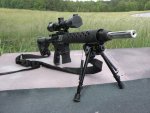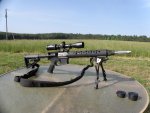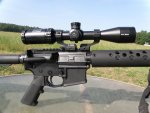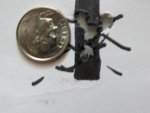Join the Hide community
Get access to live stream, lessons, the post exchange, and chat with other snipers.
Register
Download Gravity Ballistics
Get help to accurately calculate and scope your sniper rifle using real shooting data.

Install the app
How to install the app on iOS
Follow along with the video below to see how to install our site as a web app on your home screen.
Note: This feature may not be available in some browsers.
You are using an out of date browser. It may not display this or other websites correctly.
You should upgrade or use an alternative browser.
You should upgrade or use an alternative browser.
How hard is it really to be accurate at 300-400 yards with an ar 15
- Thread starter M4sniperz
- Start date
People shoot service rifle out to 600 all the time. No scope either.
Just depends on what kind of accuracy you are expecting.
Just depends on what kind of accuracy you are expecting.
That would depend on how you define accuracy, the shooters capabilities, ar platform used, ammo, environmentals, required shooting positions etc.......................
There will be a reasonable difference in hitting full size IPSC prone @ 400 vs. 4" circles standing weak side @ 400.
Tell us what you're trying to accomplish and your budget and I'm sure you will get some reasonable answers.
Things like:
-What sized are the targets you intend to hit and from what shooting positions?
-what is your practical experience shooting in this type of situation and your results so far?
-what ar platform do you intend to use(ie: barrel length, twist etc...)?
-what is your budget for an optic?
-Is this the only thing you will utilize this platform doing. If not what else and how much?
There will be a reasonable difference in hitting full size IPSC prone @ 400 vs. 4" circles standing weak side @ 400.
Tell us what you're trying to accomplish and your budget and I'm sure you will get some reasonable answers.
Things like:
-What sized are the targets you intend to hit and from what shooting positions?
-what is your practical experience shooting in this type of situation and your results so far?
-what ar platform do you intend to use(ie: barrel length, twist etc...)?
-what is your budget for an optic?
-Is this the only thing you will utilize this platform doing. If not what else and how much?
Ask SterlingShooter what you can do with an AR-15 and a sling. 600 yards iron sights prone w/ a sling and you can keep it within 12" fairly consistently. Then you get those 200-15x shooters that will keep it under 6" like a machine.
"accurate" as far as most are concerned is well within the capability of the rifle and is rarely ever detracted from by the equipment.
"accurate" as far as most are concerned is well within the capability of the rifle and is rarely ever detracted from by the equipment.
That would depend on how you define accuracy, the shooters capabilities, ar platform used, ammo, environmentals, required shooting positions etc.......................
There will be a reasonable difference in hitting full size IPSC prone @ 400 vs. 4" circles standing weak side @ 400.
Tell us what you're trying to accomplish and your budget and I'm sure you will get some reasonable answers.
Things like:
-What sized are the targets you intend to hit and from what shooting positions?
-what is your practical experience shooting in this type of situation and your results so far?
-what ar platform do you intend to use(ie: barrel length, twist etc...)?
-what is your budget for an optic?
-Is this the only thing you will utilize this platform doing. If not what else and how much?
About 6" targets prone/bench.
16" 1/7 twist ff barrel
About $500
Accurate enough that ACOGS and Elcans have hold points out to 700m... But an M4 Sniper should know that right...
Lol good point
Good solid ar15 with the right loads is very accurate up to 600yards no prob. Actually, some off my best groups at 600yards are with my ar15's!
10shots at 300yards with my rock river varmint:
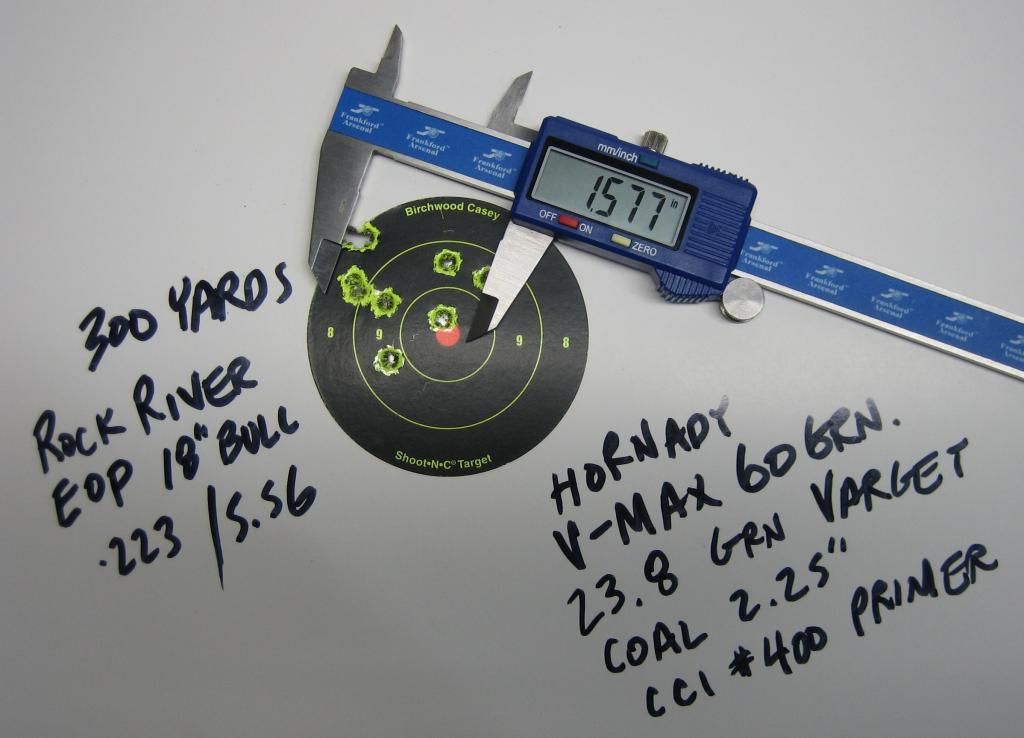
Shootout entry 300yards with rock river ath

600yards with rock river varmint
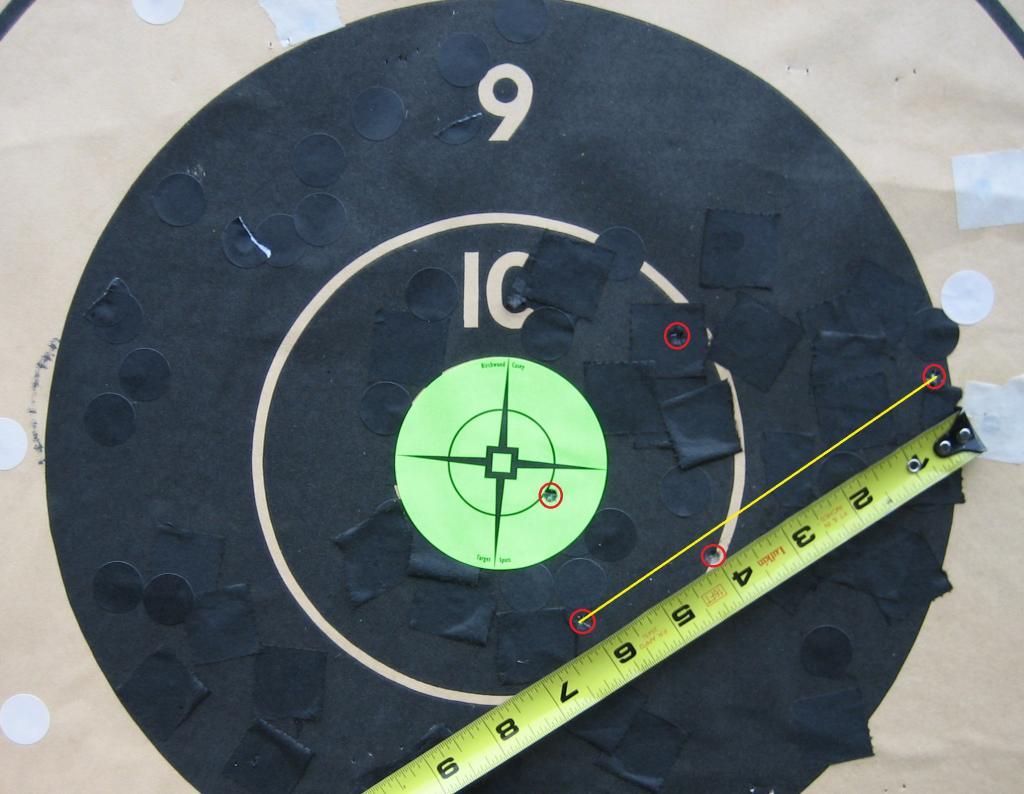
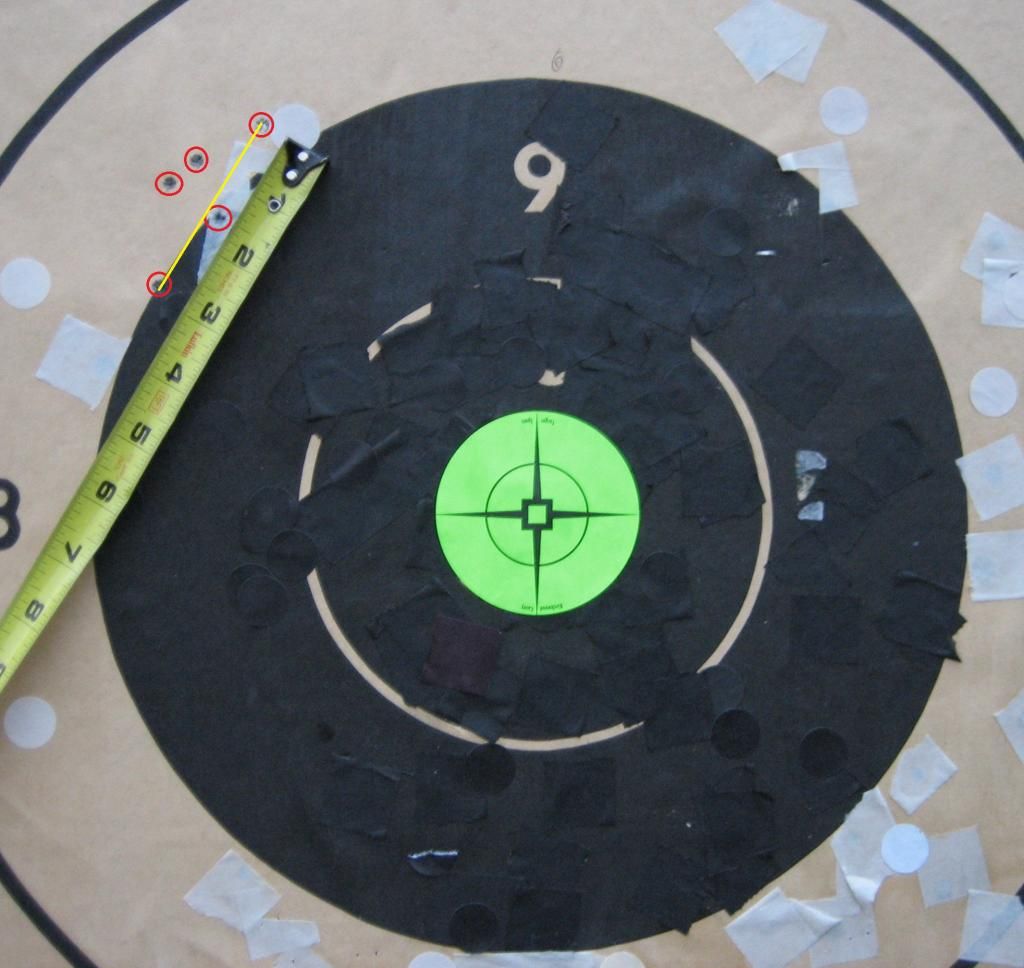
10shots at 300yards with my rock river varmint:

Shootout entry 300yards with rock river ath

600yards with rock river varmint


And what scope would be best for that distance. By ar 15 I mean .223/5.56 not an ar 10.
Last edited:
Lol good point
What ammunition are you using that wind at 300M is kicking your A$$?
OP,
Accuracy with an AR at distance is all about the bullet's B.C. If higher B.C. bullets were available better results would be possible at longer distances. In other words, B.C. helps to counter wind and weather effects on trajectory.
A shooter who knows nothing about good shooting will scope his AR and put a bipod on it. He will put it on a bench and then steer the reticle to the target without consideration for the elements and factors of a steady position. His results at SR will be very good since the bipod and scope serve as substitutes for marksmanship at short range; but, when the shooter takes it out to about 300 yards things fall apart. Why? The shooter does not have a consistent position and his arc of movement as well as recoil resistance are therefore not consistent. This inconsistency produces error which is recognized with distance. Not knowing he does not have a steady position, or that his perspective of aim is inconsistent, the shooter suspects the rifle, scope, and/or ammunition is suspect, or that wind was not correctly countered for, when in fact these factors may have had nothing to do with the cause of the shooter's misplaced shots. Now consider that wind could also be an issue, and then, since the shooter does not know the first thing about error diagnosis, this shooter is not going to get anywhere with any of it, unless he reconsiders his need for some basic marksmanship instruction on how to build a position, counter wind, and how to properly use the data book to see trends.
Accuracy with an AR at distance is all about the bullet's B.C. If higher B.C. bullets were available better results would be possible at longer distances. In other words, B.C. helps to counter wind and weather effects on trajectory.
A shooter who knows nothing about good shooting will scope his AR and put a bipod on it. He will put it on a bench and then steer the reticle to the target without consideration for the elements and factors of a steady position. His results at SR will be very good since the bipod and scope serve as substitutes for marksmanship at short range; but, when the shooter takes it out to about 300 yards things fall apart. Why? The shooter does not have a consistent position and his arc of movement as well as recoil resistance are therefore not consistent. This inconsistency produces error which is recognized with distance. Not knowing he does not have a steady position, or that his perspective of aim is inconsistent, the shooter suspects the rifle, scope, and/or ammunition is suspect, or that wind was not correctly countered for, when in fact these factors may have had nothing to do with the cause of the shooter's misplaced shots. Now consider that wind could also be an issue, and then, since the shooter does not know the first thing about error diagnosis, this shooter is not going to get anywhere with any of it, unless he reconsiders his need for some basic marksmanship instruction on how to build a position, counter wind, and how to properly use the data book to see trends.
Last edited:
What ammunition are you using that wind at 300M is kicking your A$$?
A 10 mph full value wind will produce about 3 MOA of drift at 300 yards with most any .223 ammunition. Not countering for this would displace the bullet path about 9 inches at target. I'd say that's getting your ass kicked pretty hard. The fact is at 300 yards even a hint of wind must be countered for bullet path and line of sight to intersect.
Last edited:
A 10 mph full value wind will produce about 3 MOA of drift at 300 yards with most any .223 ammunition. Not countering for this would displace the bullet path about 9 inches at target. I'd say that's getting your ass kicked pretty hard. The fact is at 300 yards even a hint of wind must be countered for bullet path and line of sight to intersect.
A full 10mph wind value isn't exactly a "hint of wind"...
Right on the money!!OP,
Accuracy with an AR at distance is all about the bullet's B.C. If higher B.C. bullets were available better results would be possible at longer distances. In other words, B.C. helps to counter wind and weather effects on trajectory.
A shooter who knows nothing about good shooting will scope his AR and put a bipod on it. He will put it on a bench and then steer the reticle to the target without consideration for the elements and factors of a steady position. His results at SR will be very good since the bipod and scope serve as substitutes for marksmanship at short range; but, when the shooter takes it out to about 300 yards things fall apart. Why? The shooter does not have a consistent position and his arc of movement as well as recoil resistance are therefore not consistent. This inconsistency produces error which is recognized with distance. Not knowing he does not have a steady position, or that his perspective of aim is inconsistent, the shooter suspects the rifle, scope, and/or ammunition is suspect, or that wind was not correctly countered for, when in fact these factors may have had nothing to do with the cause of the shooter's misplaced shots. Now consider that wind could also be an issue, and then, since the shooter does not know the first thing about error diagnosis, this shooter is not going to get anywhere with any of it, unless he reconsiders his need for some basic marksmanship instruction on how to build a position, counter wind, and how to properly use the data book to see trends.
I shoot 40gr varmint ballistic tips behind CFE 223 out of my rock river coyote eop and could hit a half dollar at 300yds easy. All I have for optics is a cheap cabelas 4-16 comensated drop reticle. The scope doesn't return to zero worth a damn, but if I leave it alone and just use the reticle, it shoots just fine. Mind you, to get this accuracy, I spent many an hour at the reloading bench and at the range working up a load that works for my rifle. It also IMHO greatly depends on the type of at you are shooting.
Sent from my RM-860_nam_usa_100 using Tapatalk
Sent from my RM-860_nam_usa_100 using Tapatalk
I love my Bushnell AR/223 scope with 4.5-18x40mm zoom. The turrets are as repeatable as my Vortex 6-24x50mm PST FFP MOA scope. At 18 power I can easily see the .22 bullet holes in my 100 yd. targets.
BUSHNELL 4.5-18X40 BDC RETICLE TARGET AR-SCOPE | Sportsman's Outdoor Superstore ( I got it here on sale for $174. )
My rifle is a Colt LE 6920 lower with a Geissle SSA-E trigger with a WOA 18" varmint upper with 1 in 7" twist and fluted to save some weight. I have shot 5 shots at 100 yds. as small as .375". This is the very first group I shot after taking 2 shots to sight in the scope. I was using my hunting bullets from last deer season. They were Sierra 65 gr. Game Kings. The much smaller groups were with Sierra 69 gr. Match Kings.
Good deal here. I ordered two boxes of them today.
http://www.midwayusa.com/product/19...ain-spitzer-boat-tail-box-of-100?cm_vc=PopCat
Eventually I find out how good it shoots at long range.
BUSHNELL 4.5-18X40 BDC RETICLE TARGET AR-SCOPE | Sportsman's Outdoor Superstore ( I got it here on sale for $174. )
My rifle is a Colt LE 6920 lower with a Geissle SSA-E trigger with a WOA 18" varmint upper with 1 in 7" twist and fluted to save some weight. I have shot 5 shots at 100 yds. as small as .375". This is the very first group I shot after taking 2 shots to sight in the scope. I was using my hunting bullets from last deer season. They were Sierra 65 gr. Game Kings. The much smaller groups were with Sierra 69 gr. Match Kings.
Good deal here. I ordered two boxes of them today.
http://www.midwayusa.com/product/19...ain-spitzer-boat-tail-box-of-100?cm_vc=PopCat
Eventually I find out how good it shoots at long range.
Attachments
Last edited:
A full 10mph wind value isn't exactly a "hint of wind"...
A hint of wind would be feeling it on the face. That's to say, that would be the first thing a shooter would notice while occupied with the firing tasks, giving the shooter a hint that he might want to adjust his sight. This effect is worth 3 to 5 mph and would be bracketed to 4 mph for a good hit. At full value this wind produces about 3 to 4 inches of drift at 300 yards. A shooter looking for a high X count on the 3 inch diameter X ring would therefore need to adjust for such wind to get the desired result; and, an inexperienced shooter making no sight adjustment would just be plain disappointed in the result. This shooter is likely to keep his sight at beginning zero nevertheless even when shots are annotated in the score book as not going on call since novice shooters usually do not have enough confidence to take the leap of faith that initial sight adjustment may require, or they do not yet understand what the rifle will do is limited to what the shooter can do and not the other way around.
Last edited:
That takes a good barrel and good ammo......only a few factory stock AR`s will do it..............
A hint of wind would be feeling it on the face. That's to say, that would be the first thing a shooter would notice while occupied with the firing tasks, giving the shooter a hint that he might want to adjust his sight. This effect is worth 3 to 5 mph and would be bracketed to 4 mph for a good hit. At full value this wind produces about 3 to 4 inches of drift at 300 yards. A shooter looking for a high X count on the 3 inch diameter X ring would therefore need to adjust for such wind to get the desired result; and, an inexperienced shooter making no sight adjustment would just be plain disappointed in the result. This shooter is likely to keep his sight at beginning zero nevertheless even when shots are annotated in the score book as not going on call since novice shooters usually do not have enough confidence to take the leap of faith that initial sight adjustment may require, or they do not yet understand what the rifle will do is limited to what the shooter can do and not the other way around.
I know what a hint of wind is. You know I was inferring your comment about a 10mph wind value being just a hint which it's not...
I never stated a 10 mph wind was a hint of wind. Re read my post.I know what a hint of wind is. You know I was inferring your comment about a 10mph wind value being just a hint which it's not...
Last edited:
I'd add, an accurate AR is possible out to any distance the bullet can get to nose-on.An accurate 300-400 AR is possible with the right ammo.
A full 10mph wind value isn't exactly a "hint of wind"...
You would be surprised and I used to think that as well. However; over the years, the more I shoot, the more I learn to read the wind and the more matches I go to; the more Ive realized that the majority of my shooting is during wind conditions that are just under full value to 1.5x full so 7mph-15mph has become the normal conditions. If youre just going to the range on the weekends then yeah you can pick a nice day. If you want to shoot in real world conditions and become a better shooter, go to the range when you think its too windy to do so. On windy days, ill usually go outside just stand there looking at the wind conditions and how they change as they go across a field/valley taking into account the way the crops move and the trees move etc. Ill do my best to read the wind without any instruments such as a kestrel, then ill pull out the kestrel to see how close I really was in my guess. If you think hitting a 10" target at 500 is cool in ideal conditions, you'll be amazed at how you feel to go out in switchy wind between 7-15mph and make a cold bore on that same target. I personally think you should be somewhat outside your comfort zone with practicing as thats the only way you'll get better.
FYI, Im getting 2-2.5" groups at 400 with my 20" 1:7.7 AR
Join the Marines, you'll shoot 500yds with iron sights in bootcamp. I shoot 300-400 yd targets with an eotech on a 10.5" M4 all the time.
If you want to shoot in real world conditions and become a better shooter, go to the range when you think its too windy to do so.
But then how would we shoot tiny groups that we can post online and brag about?? ;-)
You would be surprised and I used to think that as well. However; over the years, the more I shoot, the more I learn to read the wind and the more matches I go to; the more Ive realized that the majority of my shooting is during wind conditions that are just under full value to 1.5x full so 7mph-15mph has become the normal conditions. If youre just going to the range on the weekends then yeah you can pick a nice day. If you want to shoot in real world conditions and become a better shooter, go to the range when you think its too windy to do so. On windy days, ill usually go outside just stand there looking at the wind conditions and how they change as they go across a field/valley taking into account the way the crops move and the trees move etc. Ill do my best to read the wind without any instruments such as a kestrel, then ill pull out the kestrel to see how close I really was in my guess. If you think hitting a 10" target at 500 is cool in ideal conditions, you'll be amazed at how you feel to go out in switchy wind between 7-15mph and make a cold bore on that same target. I personally think you should be somewhat outside your comfort zone with practicing as thats the only way you'll get better.
FYI, Im getting 2-2.5" groups at 400 with my 20" 1:7.7 AR
I don't really go to ranges anymore unless I need to zero real quick or do load development. I used to shoot matches and I shoot a LOT on public land with cross canyons so I understand wind values. My SPR build I've taken out to 905yds with 77 SMK...
I never stated a 10 mph wind was a hint of wind. Re read my post.
I saw your comment before you decided to edit it ... When you talk about 10mph wind in the same paragraph it's implied that's what you're using for your example in relation to the rest of the paragraph. That's not a reading comprehension issue but a grammatical error on your part if you decided to rationalize it with a different set of parameters but not include those parameters or start a new paragraph.
I don't really go to ranges anymore unless I need to zero real quick or do load development. I used to shoot matches and I shoot a LOT on public land with cross canyons so I understand wind values. My SPR build I've taken out to 905yds with 77 SMK...
The 77smk is a great bullet IMO. Maybe not the best choice for long range .223 but Ive taken them to 1K and went 3 for 3 on a 12" square after 2 sighters. I quit after that because I wanted to end on a high note.
Not hard at all. I've got a 1/7 twist barrel shooting 75 grain match ammo with a 10 power scope. I feel comfortable taking head shots at 300.
Sierracharlie out....
Sierracharlie out....
^^^^ i was spotting it, and it happened .
I never doubted he did... lol...
I would like to start out with some basic stuff first:
It sounds like you are starting to take being an accurate shooter seriously.
Find a person that has a spotting scope and is willing to serve as your coach for the day and give them a pen and pad to record your called shots in order of shots fired along with the accrual hit location as marked... Take you time for it is not a race, it is called practice.
Keep track of the percent of the correct called shots...that number should improve over time.
your coach should be looking over you shoulder to see if you flinch as they load a live round or dummy round.
Now you are ready to shoot for record after the Live/Dummy practice session.
Compare you called shots with you hits on paper and try to get feedback after each shot from your coach.
If you want to compensate for the stress of competition you may chose to adjust your sights about one MOA up to the 10:30 position.
Most competitor right handed shooters will string down to the right.
Glad to see another person that would like to improve their shooting...
It sounds like you are starting to take being an accurate shooter seriously.
Find a person that has a spotting scope and is willing to serve as your coach for the day and give them a pen and pad to record your called shots in order of shots fired along with the accrual hit location as marked... Take you time for it is not a race, it is called practice.
Keep track of the percent of the correct called shots...that number should improve over time.
your coach should be looking over you shoulder to see if you flinch as they load a live round or dummy round.
Now you are ready to shoot for record after the Live/Dummy practice session.
Compare you called shots with you hits on paper and try to get feedback after each shot from your coach.
If you want to compensate for the stress of competition you may chose to adjust your sights about one MOA up to the 10:30 position.
Most competitor right handed shooters will string down to the right.
Glad to see another person that would like to improve their shooting...
^^^^ i was spotting it, and it happened .
HAHA.. where you the guy shooting the bolt 223 with the 80grainers that borrowed my magnetospeed? Im headed out this weekend for the open range day. Ill be bringing the .223 again for some plinking fun after getting the 6.5 all dialed in.
Last edited:
What do the very experienced shooters here think is the best bullet for long range semi auto .223? I've been using Black Hills 77g SMK, (in a JP franken gun 1:8 twist) but looking at the price of the 75g blue box, wondering what I would give up if I made a switch.
It is my opinion, *not as experienced as many here* that one of the best ways to build solid foundation for shooting is to spend a lot of time shooting a good quality .22 on a 50' indoor range. This type of shooting it seems to me builds solid fundamentals. (trigger control, position, breathing, confidence etc.)
It is my opinion, *not as experienced as many here* that one of the best ways to build solid foundation for shooting is to spend a lot of time shooting a good quality .22 on a 50' indoor range. This type of shooting it seems to me builds solid fundamentals. (trigger control, position, breathing, confidence etc.)
Last edited:
What do the very experienced shooters here think is the best bullet for long range semi auto .223? I've been using Black Hills 77g SMK, (in a JP franken gun 1:8 twist) but looking at the price of the 75g blue box, wondering what I would give up if I made a switch.
It is my opinion, *not as experienced as many here* that one of the best ways to build solid foundation for shooting is to spend a lot of time shooting a good quality .22 on a 50' indoor range. This type of shooting it seems to me builds solid fundamentals. (trigger control, position, breathing, confidence etc.)
IMO every gun is different. Mine really liked 77 SMK, but I've seen others who performed better with 75 BTHP. I would do some load development on both and see which one performs best at distance.
The best information I got was it all depends on the resonant frequency match between the rifle barrel length to the weight and velocity of the bullet.
I shot a clover leaf group at 100 yards using 2700 FPS in my Colt H-Bar AR-15 and a four inch group using 3100 FPS Winchester ammo.
The colt likes the 2700 FPS ammo much better.
I have heard of reports from Camp Perry of shooters using much longer bullets for the long shots were they needed to be loaded by hand because they would not fit in the magazine.
The basic rule is that longer and heavier is better for the better B/C factor.
The Swedish 6.5 is a good example of an inherently accurate round because of the bullet shape and size.
You would be lucky to find a factory round that fits your rifles tuning for accuracy.
Most of the top shooters will custom load to the rifle.
I shot a clover leaf group at 100 yards using 2700 FPS in my Colt H-Bar AR-15 and a four inch group using 3100 FPS Winchester ammo.
The colt likes the 2700 FPS ammo much better.
I have heard of reports from Camp Perry of shooters using much longer bullets for the long shots were they needed to be loaded by hand because they would not fit in the magazine.
The basic rule is that longer and heavier is better for the better B/C factor.
The Swedish 6.5 is a good example of an inherently accurate round because of the bullet shape and size.
You would be lucky to find a factory round that fits your rifles tuning for accuracy.
Most of the top shooters will custom load to the rifle.
How hard is it really to be accurate at 300-400 yards with an ar 15
It's got nothing to do with any 'resonant frequency match between bullet and barrel length', or velocity in a particular rifle.
Colt HBAR chambers are long, the 80 SMKs need to be at 2.550 for a GI chamber.
It's got nothing to do with any 'resonant frequency match between bullet and barrel length', or velocity in a particular rifle.
Colt HBAR chambers are long, the 80 SMKs need to be at 2.550 for a GI chamber.
Some folks seem amazed about the great results that are within their means shooting the AR at 300 yards; but, according to the NRA 300 yards is considered short range. In other words, it's no big deal.
Some of my impressions on AR performance at mid and long range: At 600 yards I can shoot my match conditioned AR based Service Rifle just about as well as my 6.5/284 fitted with match iron sights; thus, with the AR at 600, HM scores are expected. At 1000 yards no doubt the .223 is not likely to be shot as well as laser like rounds, but, as shot from an AR with irons, the .223 at 1000 is more fun than anything else I've brought to the firing line; and, it supports a higher level of learning than anything else I've taken to 1000.
I'd suggest to all shooters aspiring to become really good shooters that they might want to try out NRA LR Service Rifle Division Competition with a match conditioned commercial equivalent of the M16A2. Get to where you can occasionally shoot in the 190 arena and you will indeed have reason to be amazed, with both the rifle and your skill.
One more thing, if your mindset is about proving you know how to shoot you might want to stay away from the AR and irons for LR, since shooting the AR with irons at LR will actually prove you are not as good a shooter that you had thought yourself to be. It does not serve as a substitute for poor marksmanship as may other types of rifles and rounds.
Some of my impressions on AR performance at mid and long range: At 600 yards I can shoot my match conditioned AR based Service Rifle just about as well as my 6.5/284 fitted with match iron sights; thus, with the AR at 600, HM scores are expected. At 1000 yards no doubt the .223 is not likely to be shot as well as laser like rounds, but, as shot from an AR with irons, the .223 at 1000 is more fun than anything else I've brought to the firing line; and, it supports a higher level of learning than anything else I've taken to 1000.
I'd suggest to all shooters aspiring to become really good shooters that they might want to try out NRA LR Service Rifle Division Competition with a match conditioned commercial equivalent of the M16A2. Get to where you can occasionally shoot in the 190 arena and you will indeed have reason to be amazed, with both the rifle and your skill.
One more thing, if your mindset is about proving you know how to shoot you might want to stay away from the AR and irons for LR, since shooting the AR with irons at LR will actually prove you are not as good a shooter that you had thought yourself to be. It does not serve as a substitute for poor marksmanship as may other types of rifles and rounds.
Last edited:
...well,Sir,...One more thing, if your mindset is about proving you know how to shoot you might want to stay away from the AR and irons for LR. Shooting it a LR will not support confirmation that you know anything about good shooting.
even worse, for MY ego, has been (and is at today) shooting an M16A2 toy-clone in .22 rimfire, prone,sling & irons...
cheaper? yes_ forgiving? not_
It's got nothing to do with any 'resonant frequency match between bullet and barrel length', or velocity in a particular rifle.
Colt HBAR chambers are long, the 80 SMKs need to be at 2.550 for a GI chamber.
Try to tell that to the Gunny at stony point MTU that coached the sniper unit.
Some folks seem amazed about the great results that are within their means shooting the AR at 300 yards; but, according to the NRA 300 yards is considered short range. In other words, it's no big deal.
Some of my impressions on AR performance at mid and long range: At 600 yards I can shoot my match conditioned AR based Service Rifle just about as well as my 6.5/284 fitted with match iron sights; thus, with the AR at 600, HM scores are expected. At 1000 yards no doubt the .223 is not likely to be shot as well as laser like rounds, but, as shot from an AR with irons, the .223 at 1000 is more fun than anything else I've brought to the firing line; and, it supports a higher level of learning than anything else I've taken to 1000.
I'd suggest to all shooters aspiring to become really good shooters that they might want to try out NRA LR Service Rifle Division Competition with a match conditioned commercial equivalent of the M16A2. Get to where you can occasionally shoot in the 190 arena and you will indeed have reason to be amazed, with both the rifle and your skill.
One more thing, if your mindset is about proving you know how to shoot you might want to stay away from the AR and irons for LR, since shooting the AR with irons at LR will actually prove you are not as good a shooter that you had thought yourself to be. It does not serve as a substitute for poor marksmanship as may other types of rifles and rounds.
I am impressed!
Your credentials are way up there and it is good to meet you...
I did the same thing for the US army back in 69 while serving in Germany.
Top shooter and assistant coach for the army.
Stay with me here as you know what your are talking about!
High Master shooter.
Try to tell that to the Gunny at stony point MTU that coached the sniper unit.
New to the hide and name dropping units? Lol...
I am impressed!
Your credentials are way up there and it is good to meet you...
I did the same thing for the US army back in 69 while serving in Germany.
Top shooter and assistant coach for the army.
Stay with me here as you know what your are talking about!
High Master shooter.
And now ass kissing? Lol...
There is no need to kiss my ass just because I was a MUCH better shooter then you!
I ran with the big dogs and you just ran...
I ran with the big dogs and you just ran...
That was one of the big problems I had when I was in the game.
There were guys that liked and respected me for my skills and others that just want to act like fool that were jealous.
It was the old gun slinger problem as there was always someone out there wanting to challenge to top gun.
I stopped counting the bodies I left behind long ago...
There were guys that liked and respected me for my skills and others that just want to act like fool that were jealous.
It was the old gun slinger problem as there was always someone out there wanting to challenge to top gun.
I stopped counting the bodies I left behind long ago...
A mil-grade barrel or better. Performance factory load or good hand loads will shoot to 500 yards easily. Wind will give you the most problems with AR 15 type rifles with 55-62 grain bullets a 10 mpg wind at 500 yards it will move your bullet as much as 40" depending on your bullet speed. With little to no wind these rifles are great out to 500 yards.
Similar threads
- Replies
- 46
- Views
- 2K
- Replies
- 6
- Views
- 445
